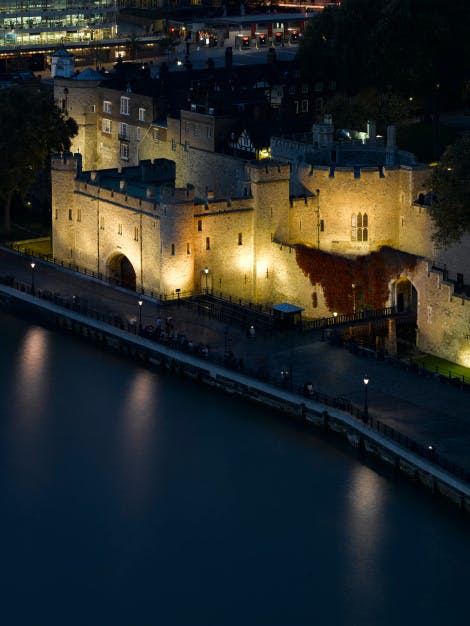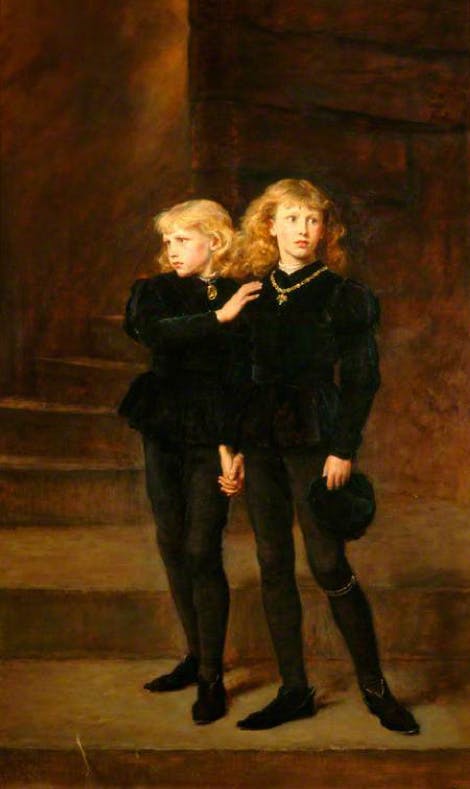
Explore the defensive walls and towers that have protected for centuries
Skip the event ticket details and go to event summary.
When
OpenTicketing information
Included in palace admission (Members go free)
Buy Tower of London ticketsThere is no lift/ramp access to the Battlements. For more information, please visit the Tower accessibility page.
Walk the Tower's famous walls
Take the Wall Walk and explore a series of imposing towers filled with stories and secrets. Discover how these formidable walls once formed part of a luxurious royal palace, contained wild beasts and prisoners, and protected the fortress.
Along the way, delve into the different roles the Tower of London has played, from Medieval times right through to the 20th century. Plus enjoy panoramic views of the Tower, the Thames and the City of London.
There are three different sections of the Wall Walk to explore:
Join the one way system from the Medieval Palace; near the Salt Tower; or by Martin Tower.

The Inner and Outer Curtain Wall
The Tower’s huge stone walls, which are formed of two concentric rings – the Inner Curtain Wall, and the Outer Curtain Wall - have protected kings and queens for centuries.
The battlements that you can walk along are sections of the Inner Curtain Wall. Imagine stepping onto these mighty walls as royalty or a condemned traitor!
The Inner Curtain Wall was built during Henry III's fortification of the Tower between 1240-60, while the Outer Curtain Wall was built during the expansion of the fortress during the reign of Henry’s son, Edward I.
Did you know?
Defensive walls, also called a ballium, rampart, or curtain, are integral features of castles – providing not only safety from outside, but also a way to confine those within.


South Battlements
Medieval Palace
Beginning at St Thomas’s Tower, the Medieval Palace brings the world of Edward I and Henry III to life. Soak up the grandeur of the royal apartments set above a magnificent archway, now known as the notorious Traitor’s Gate. This gate was originally a high status river entrance which allowed access to the royal apartments in medieval times.
Emerging from the Wakefield Tower, presented as Henry III’s throne room, you are hit with stunning 360 views looking over to the White Tower on one side and the Thames on the other.
These walls, and the Lanthorn Tower, are a Victorian imagining of the lost medieval walls. The river used to come right up to these now lost walls before the Outer Curtain was constructed by Edward I between 1280-90.
The walkway below, towards the River Thames, is called Water Lane as it once formed part of the river. After exiting the Lanthorn Tower, don't miss Edward III’s royal watergate – The Cradle Tower, which holds the Tower’s oldest medieval vault (ceiling) where more of the medieval world is brought to life.
Salt Tower
At the far end of the Southern Inner Wall, you will find graffiti scratched into the walls of the Salt Tower - left by prisoners almost 500 years ago.
This tower originally overlooked the Thames, and in times of trouble, archers on the ground floor were able to protect it by shooting through the five arrow loops. During peaceful times the room was a storehouse.
East Battlements
The Eastern Wall Walk recreates what it was like to prepare for conflict and defend the fortress in battle. Look down from the battlements here and you will also notice accommodation built into the outer walls, called the Casemates, where some of today’s Yeoman Warders live.
Broad Arrow Tower
From the 14th century, the Broad Arrow Tower was connected to the government department responsible for royal supplies – the Wardrobe. Today, the Broad Arrow Tower has been re-presented as a guard tower, its original use.
Fighting Platform
This addition to the East Battlements evokes the atmosphere of a fortress in operation, where the garrison would have assembled in case of attack. Hear the troops at peace and at war, under cover of the wooden roof that would have protected them from the elements – as well as arrows!
Constable Tower
Security breached! Tower raided! Here you can explore the remarkable story of the only time the defences of the fortress were ever breached – the Peasants' Revolt of 1381.
Martin Tower
This tower houses the Yeoman Warders at the Tower exhibition, which tells the story of the Yeoman Warder community. The exhibition explores their fascinating history, ceremonies and traditions.



North Battlements
The North Battlements offer spectacular views over the City and its towering skyscrapers, such as the Walkie Talkie and the Gherkin. At the foot of these buildings lies the Tower Hill execution site, where many Tower prisoners met their fate.
Brick Tower
For 600 years, wild and exotic animals were kept at the Tower of London. Discover why they were here and what their life was like in the Tower at the Royal Beasts exhibition.
Bowyer Tower
Discover the story of the Duke of Wellington – war hero, prime minister and Constable of the Tower of London.
Flint Tower
In the 20th century, the Tower continued to play an important defensive role for Britain. Hear the story of how this ancient fortress took part in a modern-day war and came under fire itself. The North bastion on the outer wall here was damaged by a bomb in World War II.
What's on

- Things to see
White Tower
Marvel at the imposing White Tower, a magnificent example of Norman architecture at the heart of the Tower of London.
-
Open (Partial route closure on selected times and dates in December*)
- Tower of London
- Included in palace admission (Members go free)

- Things to see
Medieval Palace
Newly refurbished in May 2025, discover the colour, splendour, and people of the medieval Tower of London.
-
Open
- Tower of London
- Included in palace admission (Members go free)

- Things to see
Imprisonment at the Tower exhibition
Learn why people ended up as prisoners in the Tower of London, in the very rooms where some of them were held.
- Open
- Tower of London
- Included in palace admission (Members go free)
Browse more history and stories

The story of the Tower of London
Iconic fortress, royal palace and infamous prison.

The Princes in the Tower
Murdered or survived – what happened to Edward and his younger brother Richard?

Henry VI
Intelligent and generous, he lived in his father's shadow and was killed for his throne
Shop online

Tower of London Navy Raven Sweatshirt
Inspired by the infamous ravens of the Tower of London, this sweatshirt will keep you warm on those chilly days.
£38.00

Shop Ravens
It is said that if the six ravens were ever to leave the Tower of London then the Tower and the kingdom will fall. Naturally, to preserve the kingdom six ravens are kept to live and protect the Tower of London.
From £2.50

Shop Kings & Queens of England
Discover our informative and best selling range, inspired by the incredible history of the Kings and Queens of England.
From £4.99
